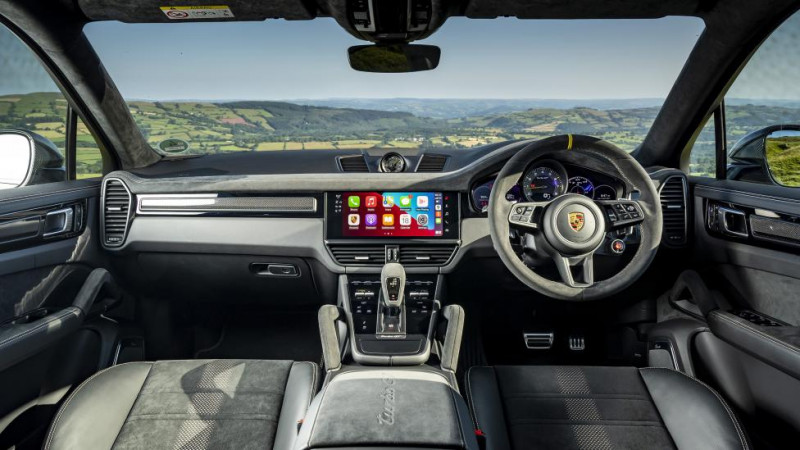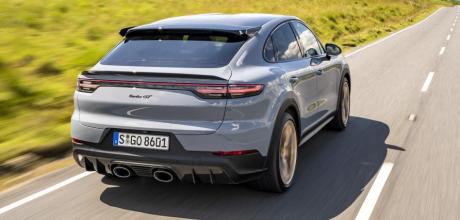2022 Porsche Cayenne Turbo GT PO536
Super-SUV gets a GT department makeover – with eye-widening results
Its radius appears tight at first sight but you can carry more speed into, through and out of this uphill right hander than initially anticipated. That the exit opens up to present an arrow-straight stretch of tarmac that’s masked by the entry is a welcome discovery. This is a good corner. Well sighted, quick enough to be a challenge, yet not so quick that you need to take liberties to enjoy it.

In, say, a 992 GT3 Touring with a manual gearbox, you’d downshift to third on approach, confident that you’ll be operating within the engine’s peak torque range at the corner exit. After a few runs you’ll pick up the throttle earlier in the turn, feel the diff hook up with more conviction as it catches then balances the torque and power distribution to the fat rear Michelins, while you wind on a couple of degrees of lock to hold it all true. It’s a good corner to flatter the driver’s ego. Even better to frazzle their mind when the car they are in isn’t a GT3 but an SUV.

Not that the Cayenne Turbo GT is simply just another uber-SUV to join the genre’s power race, although it is that too. Porschephiles will spot the GT nomenclature and ask ‘Isn’t that reserved for 911s with aero devices that make a Cessna envious?’ Yes it is, and this Cayenne has had the same forensic attention paid to the detail as the famous sports cars, and it shows.
It sits 17mm lower than a regular Cayenne Turbo Coupé and is wider too due to an increased track and front wheels that are an inch wider. Upgrades to the three-chamber air suspension have resulted in a 15 per cent stiffer ride, while recalibrated electric power steering and rear-axle steering are both unique to the Turbo GT. There’s also a bespoke set of Pirelli P Zero Corsa tyres, new software for the active anti-roll bars, torque vectoring that allows for higher diff lock ratios, new front suspension bushes to increase precision and manage unsprung weight better, and an additional 0.45 degrees of negative camber.

Experiencing the results of the GT chassis department’s work requires very little wheel time. There’s a tautness to the body that eradicates the feeling of sitting on top of a chassis rather than within it, which means there’s a stronger feeling of connection. It’s not on a par with being hardwired into a GT3 RS, because there’s no disguising that you are still looking down on pretty much everyone who isn’t in a commercial vehicle, but any SUV vagueness and feeling of being remote from what’s happening beneath you is all but eradicated.
Considering that the Cayenne is already one of the better SUVs to drive, the step up that the Turbo GT delivers impresses further still.
There is an unexpected and very welcome level of precision to how the Turbo GT responds to your inputs, and this makes it far easier to position on the road and less susceptible to being nudged off line by every camber and surface change. So while it may have been developed by those who chase aero performance, the result of the GT team’s work is one of the calmest and most relaxing SUVs for when all you want to do is arrive at point B with as little effort as possible after leaving point A.

But when you arrive at The Corner, the GT pedigree shines through. With your hands lightly gripping the Alcantara wheel and your finger having requested the requisite number of downshifts (possibly as many as five as it’s an eight-speed auto, albeit one with an additional oil cooler), you turn in and wait for the Corsas to bite and resist the forces against them before generating the traction needed. As the corner unwinds, so your right foot goes down. The revs rise, the nose lifts slightly, and where you were expecting some lag and a deep breath as 2200kg gets moving, the Turbo GT presents another unexpected sensation as the rear squats, does a little squirm and is nudged off line just enough for you to want to step in before all four Corsas regain control to deploy all of the Turbo GT’s firepower.
That firepower comes from engine work that consists of a new injection system, turbos with faster-responding innards, and a crank, rods, pistons and timing chain that are either new bespoke parts or updated from the regular Turbo items. At 631bhp and 627lb ft – increases of 89bhp and 59lb ft – there are more powerful and torque-stuffed turbocharged offerings (even within the VW-Group), but few feel as precise and tightly engineered as the Turbo GT’s 4.0-litre V8.
Combine this engine with the work carried out on the chassis and the Turbo GT is the most unlikely of performance cars because it offers more than simply straight-line performance. It is not a pure driver’s car, but it is an unexpectedly good car to drive. Good enough to make you want to turn around and push harder through that third-gear, uphill right-hander as you would in Weissach’s other GT-badged cars.
‘The Turbo GT is the most unlikely of performance cars’
- Engine V8, 3996cc, twin-turbo
- Max Power 631bhp @ 6000rpm
- Max Torque 627lb ft @ 2300-4500rpm
- Weight 2220kg (289bhp/ton)
- 0-62mph 3.3sec
- Top speed 186mph
- Basic price £143,910
- + A car this big and heavy shouldn’t drive this well
- — Still big and heavy
- DrivesToday rating 5/5
Top left: 22-inch wheels are finished in Neodyme (gold), or for an extra £387 can be platinum, satin or gloss black, or Deep Sea Blue(!); carbon-ceramic brakes are standard


